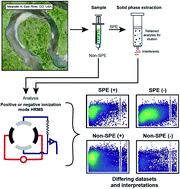Implications of sample treatment on characterization of riverine dissolved organic matter†
Abstract
High-resolution mass spectrometry techniques are widely used in the environmental sciences to characterize natural organic matter and, when utilizing these instruments, researchers must make multiple decisions regarding sample pre-treatment and the instrument ionization mode. To identify how these choices alter organic matter characterization and resulting conclusions, we analyzed a collection of 17 riverine samples from East River, CO (USA) under four PPL-based Solid Phase Extraction (SPE) treatment and electrospray ionization polarity (e.g., positive and negative) combinations: SPE (+), SPE (−), non-SPE (−), and non-SPE (+). The greatest number of formula assignments were achieved with SPE-treated samples due to the removal of compounds that could interfere with ionization. Furthermore, the SPE (−) treatment captured the most formulas across the widest chemical compound diversity. In addition to a reduced number of assigned formulas, the non-SPE datasets resulted in altered thermodynamic interpretations that could cascade into incomplete assumptions about the availability of organic matter pools for heterotrophic microbial respiration. Thus, we infer that the SPE (−) treatment is the best single method for characterizing environmental organic matter pools unless the focus is on lipid-like compounds, in which case we recommend a combination of SPE (−) and SPE (+) to adequately characterize these molecules.

- This article is part of the themed collections: Recent Open Access Articles and Geochemistry


 Please wait while we load your content...
Please wait while we load your content...